Certificate IV Business Administration: Task 1, 2, and 3 Project
VerifiedAdded on 2022/09/09
|19
|3675
|15
Project
AI Summary
This project, designed for a Certificate IV in Business Administration course, encompasses three key tasks related to implementing customer service standards and employee development. Task 1 focuses on researching and reporting on anti-discrimination legislation, including the Fair Work Act, and creating tools for performance evaluation and gathering feedback. Task 2 delves into mentoring, coaching, and learning styles, with a focus on developing individuals and teams through training plans and observation checklists. Task 3 involves planning development opportunities, collecting feedback, assessing performance, and reporting on professional development. The project includes practical elements such as self-evaluation scripts, employee feedback forms, and training strategies, providing a comprehensive overview of customer service, employee development, and legal compliance within a business context.
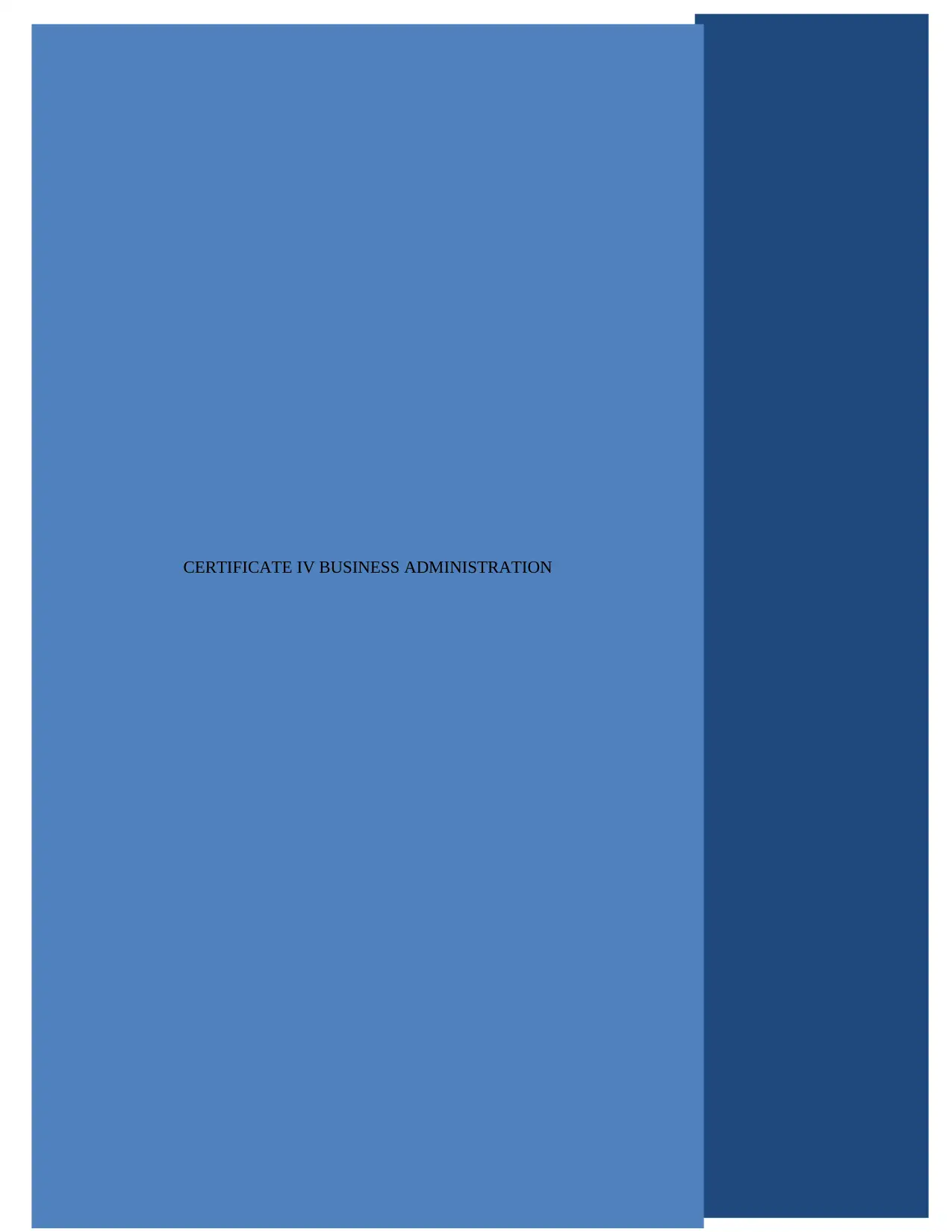
CERTIFICATE IV BUSINESS ADMINISTRATION
Paraphrase This Document
Need a fresh take? Get an instant paraphrase of this document with our AI Paraphraser
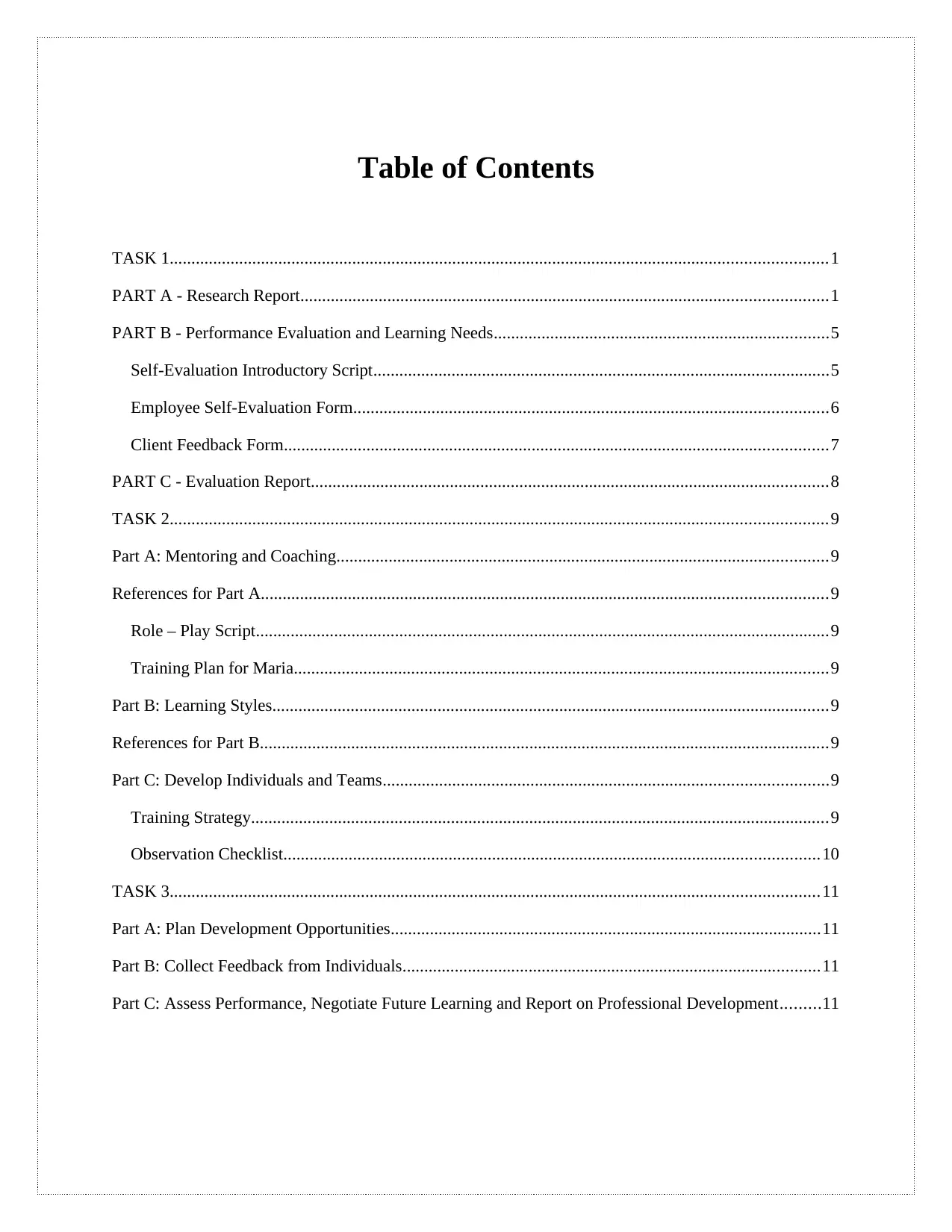
Table of Contents
TASK 1.......................................................................................................................................................1
PART A - Research Report.........................................................................................................................1
PART B - Performance Evaluation and Learning Needs.............................................................................5
Self-Evaluation Introductory Script.........................................................................................................5
Employee Self-Evaluation Form.............................................................................................................6
Client Feedback Form.............................................................................................................................7
PART C - Evaluation Report.......................................................................................................................8
TASK 2.......................................................................................................................................................9
Part A: Mentoring and Coaching.................................................................................................................9
References for Part A..................................................................................................................................9
Role – Play Script....................................................................................................................................9
Training Plan for Maria...........................................................................................................................9
Part B: Learning Styles................................................................................................................................9
References for Part B...................................................................................................................................9
Part C: Develop Individuals and Teams......................................................................................................9
Training Strategy.....................................................................................................................................9
Observation Checklist...........................................................................................................................10
TASK 3.....................................................................................................................................................11
Part A: Plan Development Opportunities...................................................................................................11
Part B: Collect Feedback from Individuals................................................................................................11
Part C: Assess Performance, Negotiate Future Learning and Report on Professional Development.........11
TASK 1.......................................................................................................................................................1
PART A - Research Report.........................................................................................................................1
PART B - Performance Evaluation and Learning Needs.............................................................................5
Self-Evaluation Introductory Script.........................................................................................................5
Employee Self-Evaluation Form.............................................................................................................6
Client Feedback Form.............................................................................................................................7
PART C - Evaluation Report.......................................................................................................................8
TASK 2.......................................................................................................................................................9
Part A: Mentoring and Coaching.................................................................................................................9
References for Part A..................................................................................................................................9
Role – Play Script....................................................................................................................................9
Training Plan for Maria...........................................................................................................................9
Part B: Learning Styles................................................................................................................................9
References for Part B...................................................................................................................................9
Part C: Develop Individuals and Teams......................................................................................................9
Training Strategy.....................................................................................................................................9
Observation Checklist...........................................................................................................................10
TASK 3.....................................................................................................................................................11
Part A: Plan Development Opportunities...................................................................................................11
Part B: Collect Feedback from Individuals................................................................................................11
Part C: Assess Performance, Negotiate Future Learning and Report on Professional Development.........11
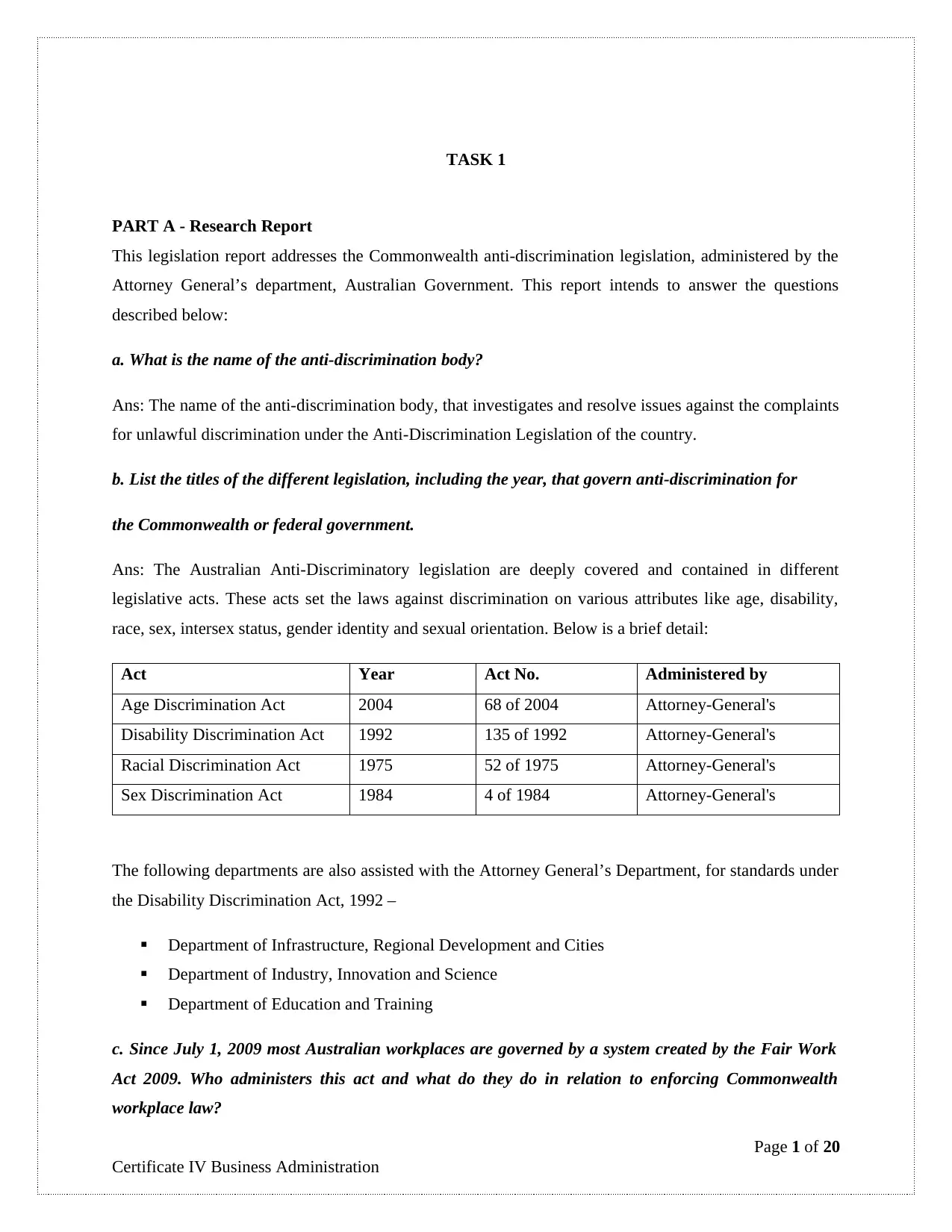
TASK 1
PART A - Research Report
This legislation report addresses the Commonwealth anti-discrimination legislation, administered by the
Attorney General’s department, Australian Government. This report intends to answer the questions
described below:
a. What is the name of the anti-discrimination body?
Ans: The name of the anti-discrimination body, that investigates and resolve issues against the complaints
for unlawful discrimination under the Anti-Discrimination Legislation of the country.
b. List the titles of the different legislation, including the year, that govern anti-discrimination for
the Commonwealth or federal government.
Ans: The Australian Anti-Discriminatory legislation are deeply covered and contained in different
legislative acts. These acts set the laws against discrimination on various attributes like age, disability,
race, sex, intersex status, gender identity and sexual orientation. Below is a brief detail:
Act Year Act No. Administered by
Age Discrimination Act 2004 68 of 2004 Attorney-General's
Disability Discrimination Act 1992 135 of 1992 Attorney-General's
Racial Discrimination Act 1975 52 of 1975 Attorney-General's
Sex Discrimination Act 1984 4 of 1984 Attorney-General's
The following departments are also assisted with the Attorney General’s Department, for standards under
the Disability Discrimination Act, 1992 –
Department of Infrastructure, Regional Development and Cities
Department of Industry, Innovation and Science
Department of Education and Training
c. Since July 1, 2009 most Australian workplaces are governed by a system created by the Fair Work
Act 2009. Who administers this act and what do they do in relation to enforcing Commonwealth
workplace law?
Page 1 of 20
Certificate IV Business Administration
PART A - Research Report
This legislation report addresses the Commonwealth anti-discrimination legislation, administered by the
Attorney General’s department, Australian Government. This report intends to answer the questions
described below:
a. What is the name of the anti-discrimination body?
Ans: The name of the anti-discrimination body, that investigates and resolve issues against the complaints
for unlawful discrimination under the Anti-Discrimination Legislation of the country.
b. List the titles of the different legislation, including the year, that govern anti-discrimination for
the Commonwealth or federal government.
Ans: The Australian Anti-Discriminatory legislation are deeply covered and contained in different
legislative acts. These acts set the laws against discrimination on various attributes like age, disability,
race, sex, intersex status, gender identity and sexual orientation. Below is a brief detail:
Act Year Act No. Administered by
Age Discrimination Act 2004 68 of 2004 Attorney-General's
Disability Discrimination Act 1992 135 of 1992 Attorney-General's
Racial Discrimination Act 1975 52 of 1975 Attorney-General's
Sex Discrimination Act 1984 4 of 1984 Attorney-General's
The following departments are also assisted with the Attorney General’s Department, for standards under
the Disability Discrimination Act, 1992 –
Department of Infrastructure, Regional Development and Cities
Department of Industry, Innovation and Science
Department of Education and Training
c. Since July 1, 2009 most Australian workplaces are governed by a system created by the Fair Work
Act 2009. Who administers this act and what do they do in relation to enforcing Commonwealth
workplace law?
Page 1 of 20
Certificate IV Business Administration
⊘ This is a preview!⊘
Do you want full access?
Subscribe today to unlock all pages.

Trusted by 1+ million students worldwide
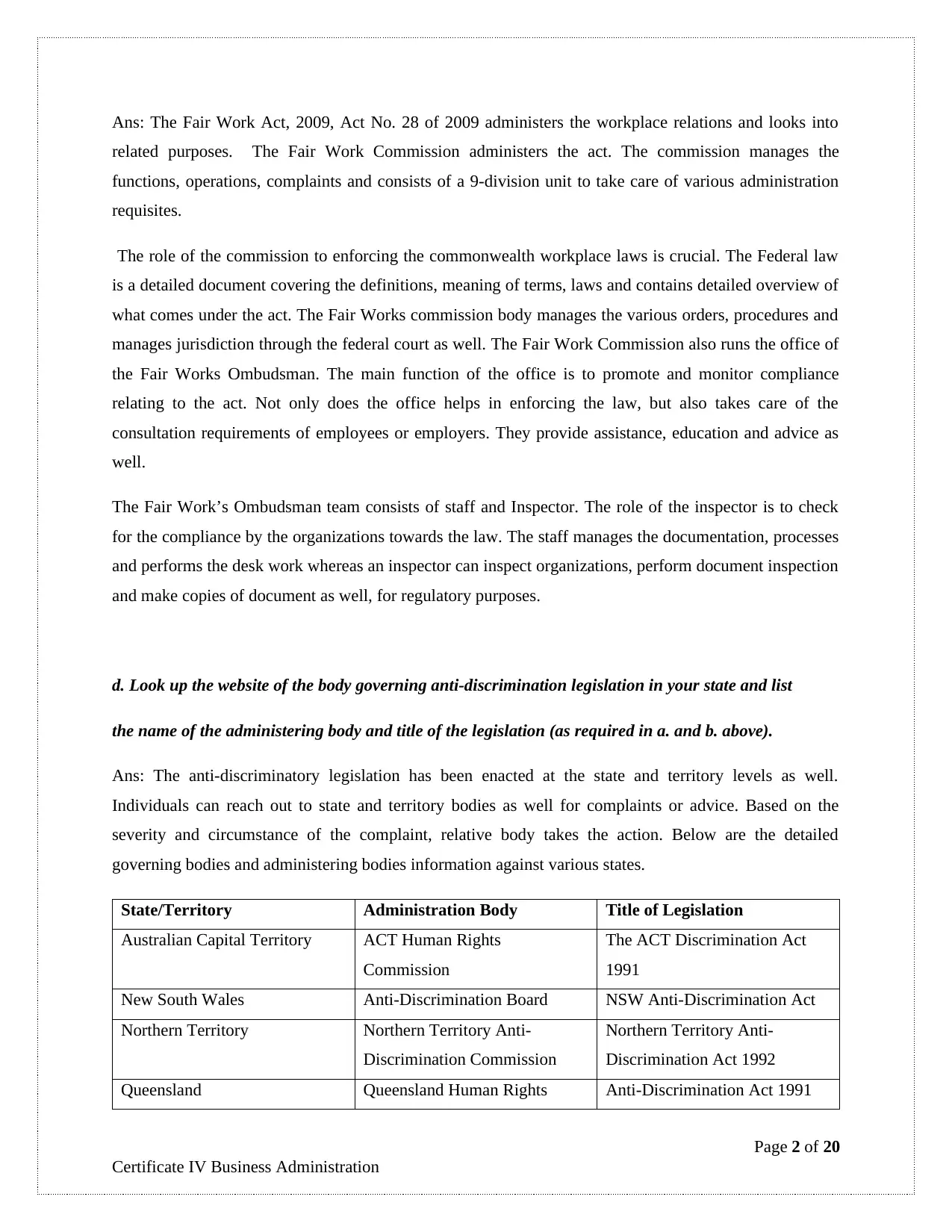
Ans: The Fair Work Act, 2009, Act No. 28 of 2009 administers the workplace relations and looks into
related purposes. The Fair Work Commission administers the act. The commission manages the
functions, operations, complaints and consists of a 9-division unit to take care of various administration
requisites.
The role of the commission to enforcing the commonwealth workplace laws is crucial. The Federal law
is a detailed document covering the definitions, meaning of terms, laws and contains detailed overview of
what comes under the act. The Fair Works commission body manages the various orders, procedures and
manages jurisdiction through the federal court as well. The Fair Work Commission also runs the office of
the Fair Works Ombudsman. The main function of the office is to promote and monitor compliance
relating to the act. Not only does the office helps in enforcing the law, but also takes care of the
consultation requirements of employees or employers. They provide assistance, education and advice as
well.
The Fair Work’s Ombudsman team consists of staff and Inspector. The role of the inspector is to check
for the compliance by the organizations towards the law. The staff manages the documentation, processes
and performs the desk work whereas an inspector can inspect organizations, perform document inspection
and make copies of document as well, for regulatory purposes.
d. Look up the website of the body governing anti-discrimination legislation in your state and list
the name of the administering body and title of the legislation (as required in a. and b. above).
Ans: The anti-discriminatory legislation has been enacted at the state and territory levels as well.
Individuals can reach out to state and territory bodies as well for complaints or advice. Based on the
severity and circumstance of the complaint, relative body takes the action. Below are the detailed
governing bodies and administering bodies information against various states.
State/Territory Administration Body Title of Legislation
Australian Capital Territory ACT Human Rights
Commission
The ACT Discrimination Act
1991
New South Wales Anti-Discrimination Board NSW Anti-Discrimination Act
Northern Territory Northern Territory Anti-
Discrimination Commission
Northern Territory Anti-
Discrimination Act 1992
Queensland Queensland Human Rights Anti-Discrimination Act 1991
Page 2 of 20
Certificate IV Business Administration
related purposes. The Fair Work Commission administers the act. The commission manages the
functions, operations, complaints and consists of a 9-division unit to take care of various administration
requisites.
The role of the commission to enforcing the commonwealth workplace laws is crucial. The Federal law
is a detailed document covering the definitions, meaning of terms, laws and contains detailed overview of
what comes under the act. The Fair Works commission body manages the various orders, procedures and
manages jurisdiction through the federal court as well. The Fair Work Commission also runs the office of
the Fair Works Ombudsman. The main function of the office is to promote and monitor compliance
relating to the act. Not only does the office helps in enforcing the law, but also takes care of the
consultation requirements of employees or employers. They provide assistance, education and advice as
well.
The Fair Work’s Ombudsman team consists of staff and Inspector. The role of the inspector is to check
for the compliance by the organizations towards the law. The staff manages the documentation, processes
and performs the desk work whereas an inspector can inspect organizations, perform document inspection
and make copies of document as well, for regulatory purposes.
d. Look up the website of the body governing anti-discrimination legislation in your state and list
the name of the administering body and title of the legislation (as required in a. and b. above).
Ans: The anti-discriminatory legislation has been enacted at the state and territory levels as well.
Individuals can reach out to state and territory bodies as well for complaints or advice. Based on the
severity and circumstance of the complaint, relative body takes the action. Below are the detailed
governing bodies and administering bodies information against various states.
State/Territory Administration Body Title of Legislation
Australian Capital Territory ACT Human Rights
Commission
The ACT Discrimination Act
1991
New South Wales Anti-Discrimination Board NSW Anti-Discrimination Act
Northern Territory Northern Territory Anti-
Discrimination Commission
Northern Territory Anti-
Discrimination Act 1992
Queensland Queensland Human Rights Anti-Discrimination Act 1991
Page 2 of 20
Certificate IV Business Administration
Paraphrase This Document
Need a fresh take? Get an instant paraphrase of this document with our AI Paraphraser
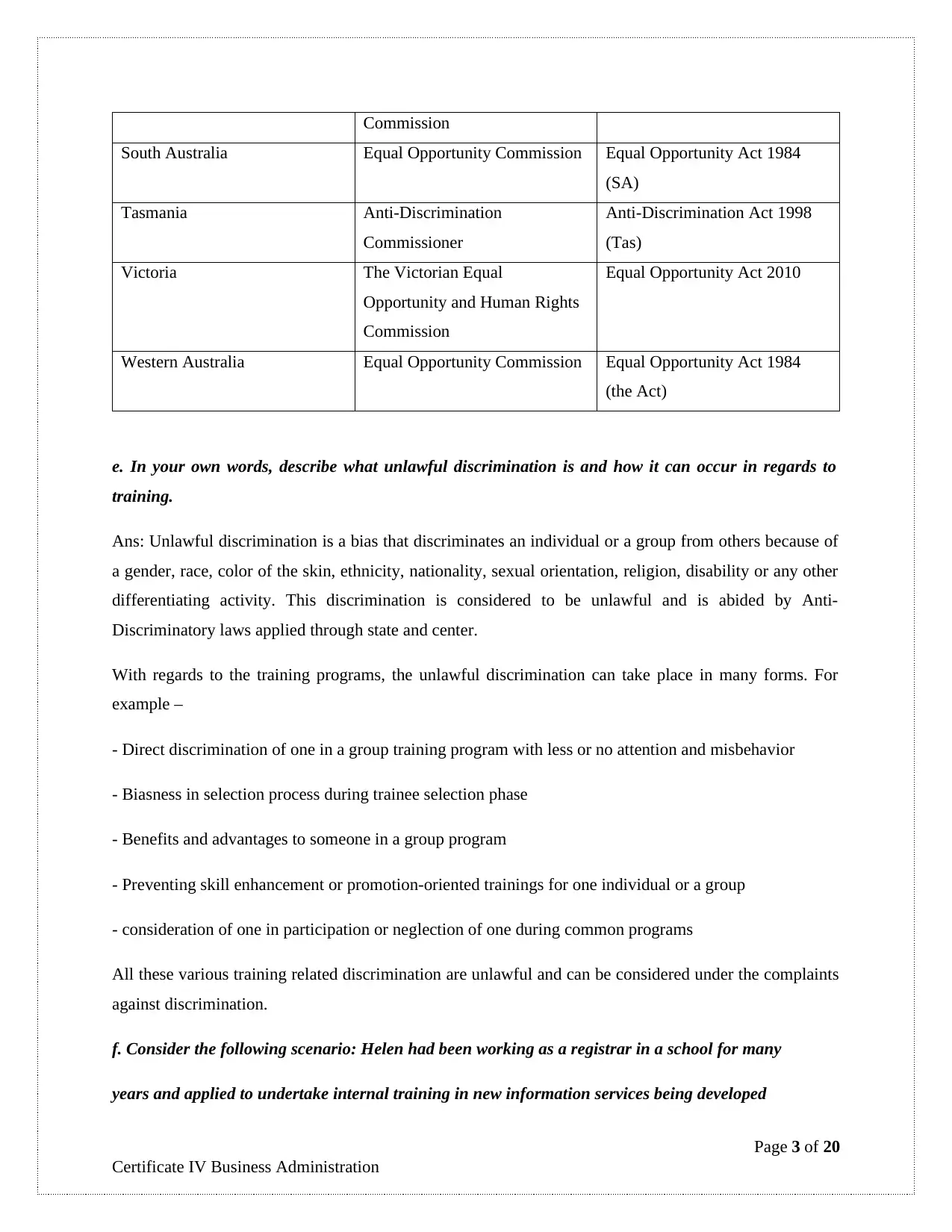
Commission
South Australia Equal Opportunity Commission Equal Opportunity Act 1984
(SA)
Tasmania Anti-Discrimination
Commissioner
Anti-Discrimination Act 1998
(Tas)
Victoria The Victorian Equal
Opportunity and Human Rights
Commission
Equal Opportunity Act 2010
Western Australia Equal Opportunity Commission Equal Opportunity Act 1984
(the Act)
e. In your own words, describe what unlawful discrimination is and how it can occur in regards to
training.
Ans: Unlawful discrimination is a bias that discriminates an individual or a group from others because of
a gender, race, color of the skin, ethnicity, nationality, sexual orientation, religion, disability or any other
differentiating activity. This discrimination is considered to be unlawful and is abided by Anti-
Discriminatory laws applied through state and center.
With regards to the training programs, the unlawful discrimination can take place in many forms. For
example –
- Direct discrimination of one in a group training program with less or no attention and misbehavior
- Biasness in selection process during trainee selection phase
- Benefits and advantages to someone in a group program
- Preventing skill enhancement or promotion-oriented trainings for one individual or a group
- consideration of one in participation or neglection of one during common programs
All these various training related discrimination are unlawful and can be considered under the complaints
against discrimination.
f. Consider the following scenario: Helen had been working as a registrar in a school for many
years and applied to undertake internal training in new information services being developed
Page 3 of 20
Certificate IV Business Administration
South Australia Equal Opportunity Commission Equal Opportunity Act 1984
(SA)
Tasmania Anti-Discrimination
Commissioner
Anti-Discrimination Act 1998
(Tas)
Victoria The Victorian Equal
Opportunity and Human Rights
Commission
Equal Opportunity Act 2010
Western Australia Equal Opportunity Commission Equal Opportunity Act 1984
(the Act)
e. In your own words, describe what unlawful discrimination is and how it can occur in regards to
training.
Ans: Unlawful discrimination is a bias that discriminates an individual or a group from others because of
a gender, race, color of the skin, ethnicity, nationality, sexual orientation, religion, disability or any other
differentiating activity. This discrimination is considered to be unlawful and is abided by Anti-
Discriminatory laws applied through state and center.
With regards to the training programs, the unlawful discrimination can take place in many forms. For
example –
- Direct discrimination of one in a group training program with less or no attention and misbehavior
- Biasness in selection process during trainee selection phase
- Benefits and advantages to someone in a group program
- Preventing skill enhancement or promotion-oriented trainings for one individual or a group
- consideration of one in participation or neglection of one during common programs
All these various training related discrimination are unlawful and can be considered under the complaints
against discrimination.
f. Consider the following scenario: Helen had been working as a registrar in a school for many
years and applied to undertake internal training in new information services being developed
Page 3 of 20
Certificate IV Business Administration
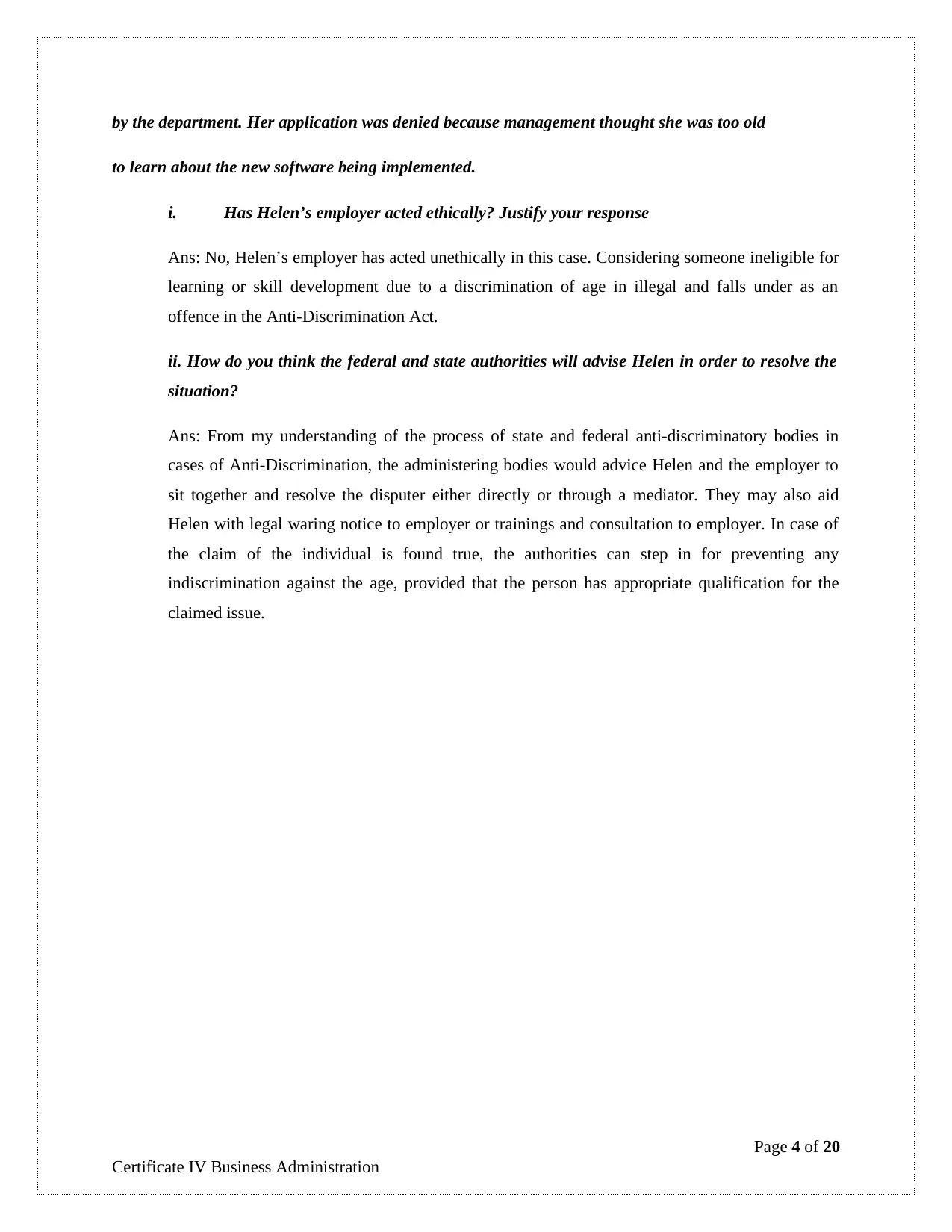
by the department. Her application was denied because management thought she was too old
to learn about the new software being implemented.
i. Has Helen’s employer acted ethically? Justify your response
Ans: No, Helen’s employer has acted unethically in this case. Considering someone ineligible for
learning or skill development due to a discrimination of age in illegal and falls under as an
offence in the Anti-Discrimination Act.
ii. How do you think the federal and state authorities will advise Helen in order to resolve the
situation?
Ans: From my understanding of the process of state and federal anti-discriminatory bodies in
cases of Anti-Discrimination, the administering bodies would advice Helen and the employer to
sit together and resolve the disputer either directly or through a mediator. They may also aid
Helen with legal waring notice to employer or trainings and consultation to employer. In case of
the claim of the individual is found true, the authorities can step in for preventing any
indiscrimination against the age, provided that the person has appropriate qualification for the
claimed issue.
Page 4 of 20
Certificate IV Business Administration
to learn about the new software being implemented.
i. Has Helen’s employer acted ethically? Justify your response
Ans: No, Helen’s employer has acted unethically in this case. Considering someone ineligible for
learning or skill development due to a discrimination of age in illegal and falls under as an
offence in the Anti-Discrimination Act.
ii. How do you think the federal and state authorities will advise Helen in order to resolve the
situation?
Ans: From my understanding of the process of state and federal anti-discriminatory bodies in
cases of Anti-Discrimination, the administering bodies would advice Helen and the employer to
sit together and resolve the disputer either directly or through a mediator. They may also aid
Helen with legal waring notice to employer or trainings and consultation to employer. In case of
the claim of the individual is found true, the authorities can step in for preventing any
indiscrimination against the age, provided that the person has appropriate qualification for the
claimed issue.
Page 4 of 20
Certificate IV Business Administration
⊘ This is a preview!⊘
Do you want full access?
Subscribe today to unlock all pages.

Trusted by 1+ million students worldwide

PART B - Performance Evaluation and Learning Needs
Self-Evaluation Introductory Script
Hello Mary,
I have called you for a very specific requirement here at the job. This meeting is purely intended to ensure
that we are able to discover a strong development and skill enhancement path for you. I would hope that
these efforts will help you in excelling in your duties and would support your day-to-day activities.
As the company has evolved, so has your role and criticality in the assigned tasks. We started on a role of
Administrative Officer and now you manage Client and Customer Service duties very efficiently. You
have been very good at the responsibilities you picked up, and therefore I would like to help you in
performing even better at your everyday responsibilities.
But, before I proceed any further, I would like to ask you that do you wish to continue on the role of
combined duties as Administrative Assistant and Customer Service Office? Also, please let me know if
you think you need a specific skill to better perform at the tasks at hand. For your skill-need assessment, I
would like to proceed with the method of self-evaluation in order to craft the right skill improvement
training program for you. Self-evaluation is a prelude to an interview. It helps in identifying the day-to-
day requirements and the learning needs.
We will complete the process in two ways, first would start with a self-evaluation feedback, that you
would fill for yourself. Second, we would collect an evaluation form from your peers and clients. That
would help us in clearly identifying your learning goals and help you in building your skillset.
I am optimistic that this will help in building a strong skill promotional activity for you and we will be
able to perform better at the job.
Page 5 of 20
Certificate IV Business Administration
Self-Evaluation Introductory Script
Hello Mary,
I have called you for a very specific requirement here at the job. This meeting is purely intended to ensure
that we are able to discover a strong development and skill enhancement path for you. I would hope that
these efforts will help you in excelling in your duties and would support your day-to-day activities.
As the company has evolved, so has your role and criticality in the assigned tasks. We started on a role of
Administrative Officer and now you manage Client and Customer Service duties very efficiently. You
have been very good at the responsibilities you picked up, and therefore I would like to help you in
performing even better at your everyday responsibilities.
But, before I proceed any further, I would like to ask you that do you wish to continue on the role of
combined duties as Administrative Assistant and Customer Service Office? Also, please let me know if
you think you need a specific skill to better perform at the tasks at hand. For your skill-need assessment, I
would like to proceed with the method of self-evaluation in order to craft the right skill improvement
training program for you. Self-evaluation is a prelude to an interview. It helps in identifying the day-to-
day requirements and the learning needs.
We will complete the process in two ways, first would start with a self-evaluation feedback, that you
would fill for yourself. Second, we would collect an evaluation form from your peers and clients. That
would help us in clearly identifying your learning goals and help you in building your skillset.
I am optimistic that this will help in building a strong skill promotional activity for you and we will be
able to perform better at the job.
Page 5 of 20
Certificate IV Business Administration
Paraphrase This Document
Need a fresh take? Get an instant paraphrase of this document with our AI Paraphraser

Employee Self-Evaluation Form
Page 6 of 20
Certificate IV Business Administration
Page 6 of 20
Certificate IV Business Administration

Client Feedback Form
Page 7 of 20
Certificate IV Business Administration
Page 7 of 20
Certificate IV Business Administration
⊘ This is a preview!⊘
Do you want full access?
Subscribe today to unlock all pages.

Trusted by 1+ million students worldwide
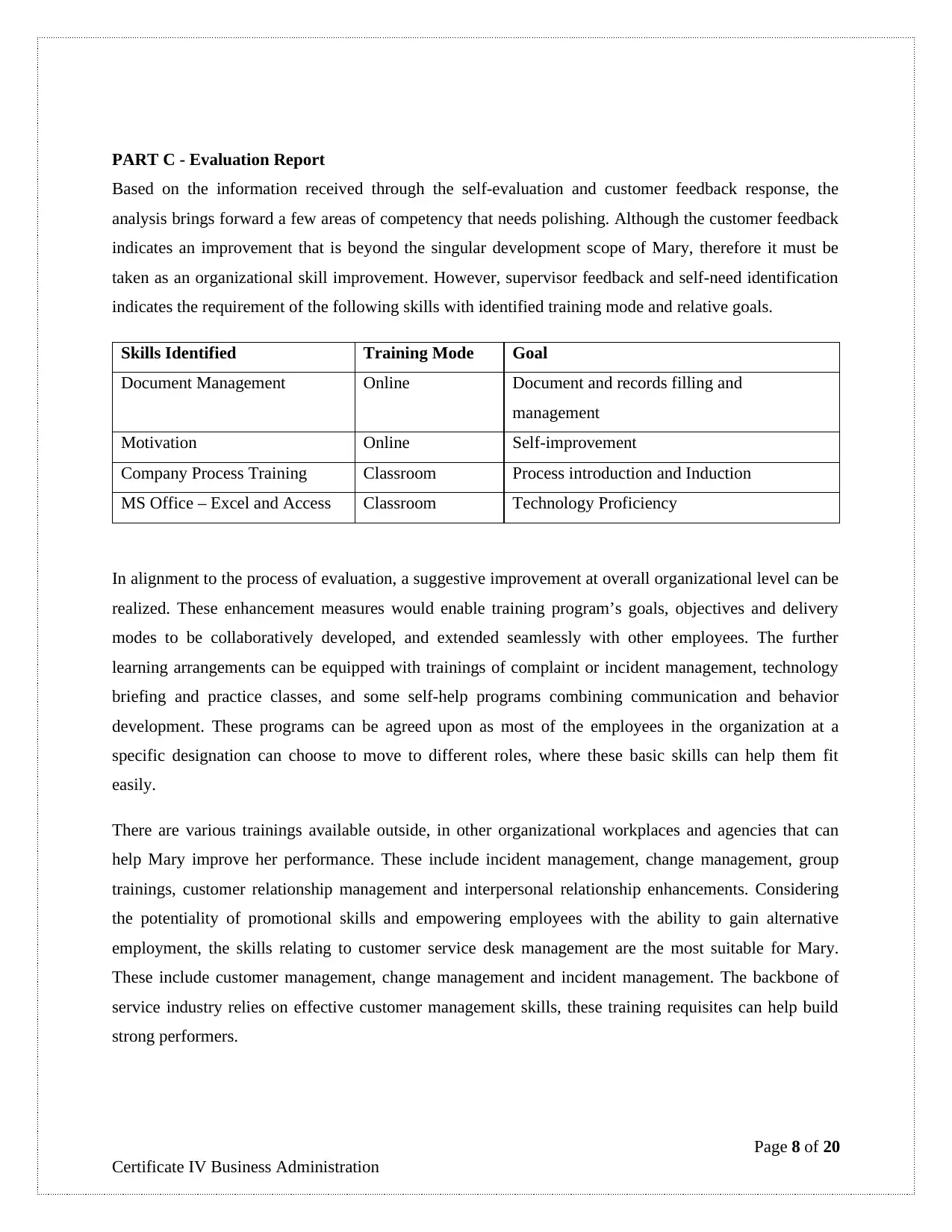
PART C - Evaluation Report
Based on the information received through the self-evaluation and customer feedback response, the
analysis brings forward a few areas of competency that needs polishing. Although the customer feedback
indicates an improvement that is beyond the singular development scope of Mary, therefore it must be
taken as an organizational skill improvement. However, supervisor feedback and self-need identification
indicates the requirement of the following skills with identified training mode and relative goals.
Skills Identified Training Mode Goal
Document Management Online Document and records filling and
management
Motivation Online Self-improvement
Company Process Training Classroom Process introduction and Induction
MS Office – Excel and Access Classroom Technology Proficiency
In alignment to the process of evaluation, a suggestive improvement at overall organizational level can be
realized. These enhancement measures would enable training program’s goals, objectives and delivery
modes to be collaboratively developed, and extended seamlessly with other employees. The further
learning arrangements can be equipped with trainings of complaint or incident management, technology
briefing and practice classes, and some self-help programs combining communication and behavior
development. These programs can be agreed upon as most of the employees in the organization at a
specific designation can choose to move to different roles, where these basic skills can help them fit
easily.
There are various trainings available outside, in other organizational workplaces and agencies that can
help Mary improve her performance. These include incident management, change management, group
trainings, customer relationship management and interpersonal relationship enhancements. Considering
the potentiality of promotional skills and empowering employees with the ability to gain alternative
employment, the skills relating to customer service desk management are the most suitable for Mary.
These include customer management, change management and incident management. The backbone of
service industry relies on effective customer management skills, these training requisites can help build
strong performers.
Page 8 of 20
Certificate IV Business Administration
Based on the information received through the self-evaluation and customer feedback response, the
analysis brings forward a few areas of competency that needs polishing. Although the customer feedback
indicates an improvement that is beyond the singular development scope of Mary, therefore it must be
taken as an organizational skill improvement. However, supervisor feedback and self-need identification
indicates the requirement of the following skills with identified training mode and relative goals.
Skills Identified Training Mode Goal
Document Management Online Document and records filling and
management
Motivation Online Self-improvement
Company Process Training Classroom Process introduction and Induction
MS Office – Excel and Access Classroom Technology Proficiency
In alignment to the process of evaluation, a suggestive improvement at overall organizational level can be
realized. These enhancement measures would enable training program’s goals, objectives and delivery
modes to be collaboratively developed, and extended seamlessly with other employees. The further
learning arrangements can be equipped with trainings of complaint or incident management, technology
briefing and practice classes, and some self-help programs combining communication and behavior
development. These programs can be agreed upon as most of the employees in the organization at a
specific designation can choose to move to different roles, where these basic skills can help them fit
easily.
There are various trainings available outside, in other organizational workplaces and agencies that can
help Mary improve her performance. These include incident management, change management, group
trainings, customer relationship management and interpersonal relationship enhancements. Considering
the potentiality of promotional skills and empowering employees with the ability to gain alternative
employment, the skills relating to customer service desk management are the most suitable for Mary.
These include customer management, change management and incident management. The backbone of
service industry relies on effective customer management skills, these training requisites can help build
strong performers.
Page 8 of 20
Certificate IV Business Administration
Paraphrase This Document
Need a fresh take? Get an instant paraphrase of this document with our AI Paraphraser
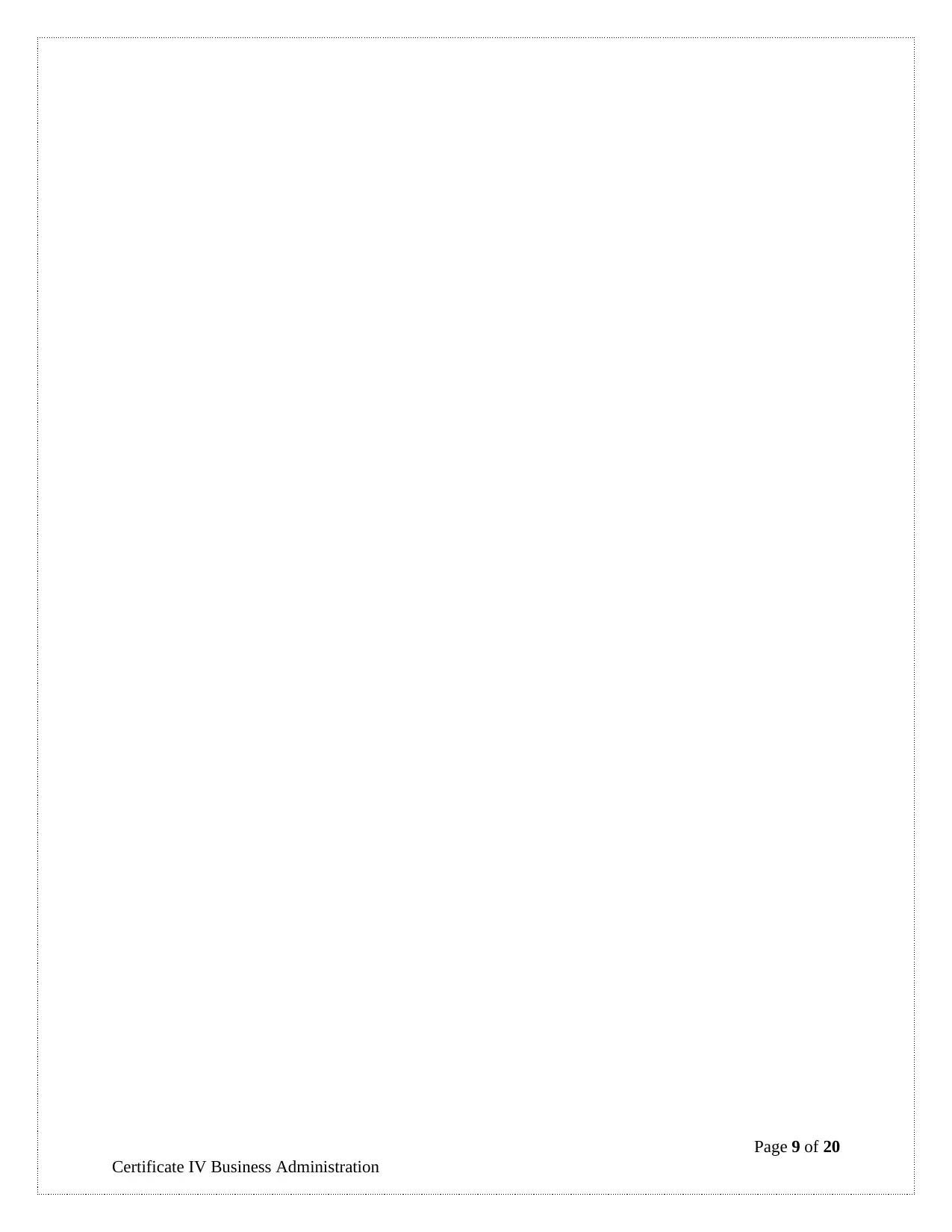
Page 9 of 20
Certificate IV Business Administration
Certificate IV Business Administration
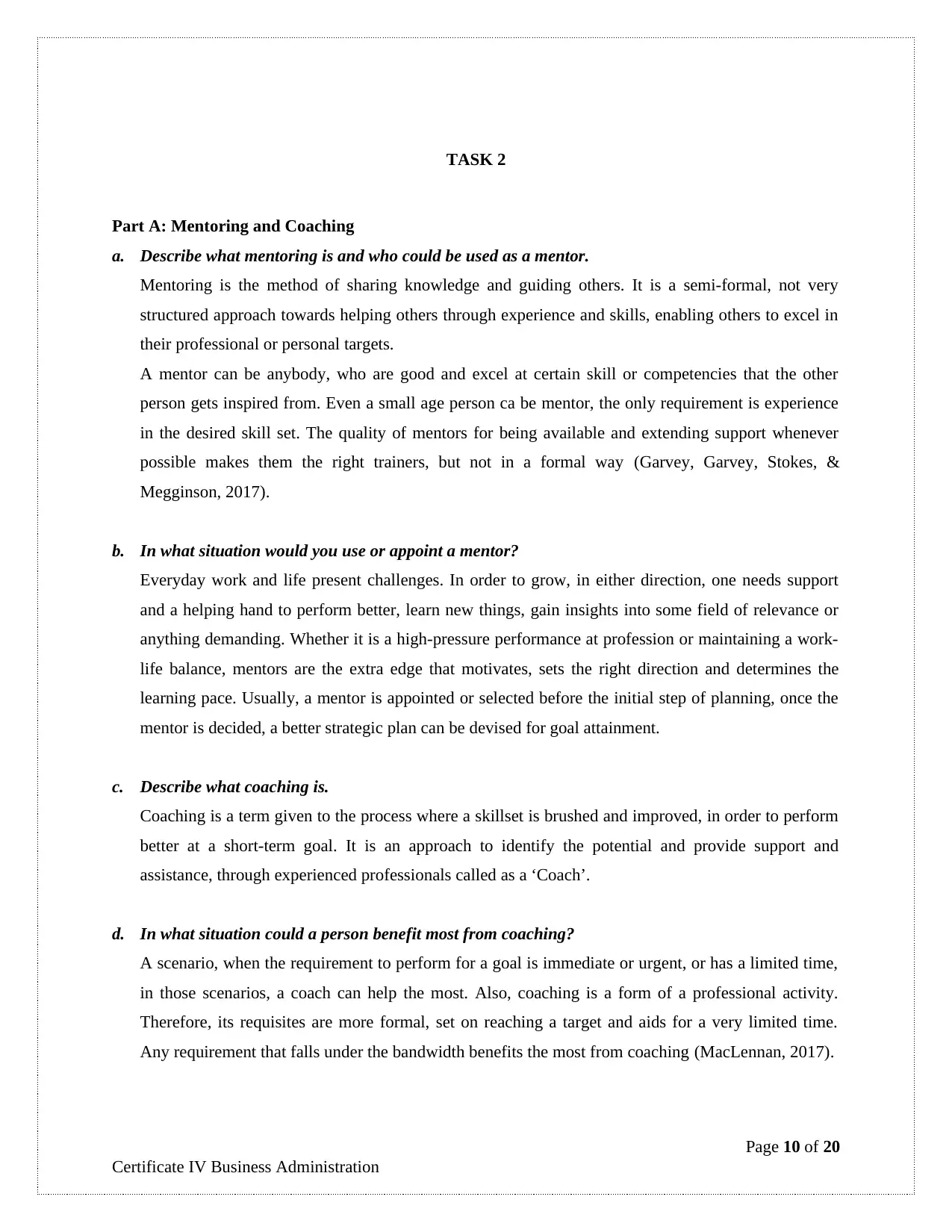
TASK 2
Part A: Mentoring and Coaching
a. Describe what mentoring is and who could be used as a mentor.
Mentoring is the method of sharing knowledge and guiding others. It is a semi-formal, not very
structured approach towards helping others through experience and skills, enabling others to excel in
their professional or personal targets.
A mentor can be anybody, who are good and excel at certain skill or competencies that the other
person gets inspired from. Even a small age person ca be mentor, the only requirement is experience
in the desired skill set. The quality of mentors for being available and extending support whenever
possible makes them the right trainers, but not in a formal way (Garvey, Garvey, Stokes, &
Megginson, 2017).
b. In what situation would you use or appoint a mentor?
Everyday work and life present challenges. In order to grow, in either direction, one needs support
and a helping hand to perform better, learn new things, gain insights into some field of relevance or
anything demanding. Whether it is a high-pressure performance at profession or maintaining a work-
life balance, mentors are the extra edge that motivates, sets the right direction and determines the
learning pace. Usually, a mentor is appointed or selected before the initial step of planning, once the
mentor is decided, a better strategic plan can be devised for goal attainment.
c. Describe what coaching is.
Coaching is a term given to the process where a skillset is brushed and improved, in order to perform
better at a short-term goal. It is an approach to identify the potential and provide support and
assistance, through experienced professionals called as a ‘Coach’.
d. In what situation could a person benefit most from coaching?
A scenario, when the requirement to perform for a goal is immediate or urgent, or has a limited time,
in those scenarios, a coach can help the most. Also, coaching is a form of a professional activity.
Therefore, its requisites are more formal, set on reaching a target and aids for a very limited time.
Any requirement that falls under the bandwidth benefits the most from coaching (MacLennan, 2017).
Page 10 of 20
Certificate IV Business Administration
Part A: Mentoring and Coaching
a. Describe what mentoring is and who could be used as a mentor.
Mentoring is the method of sharing knowledge and guiding others. It is a semi-formal, not very
structured approach towards helping others through experience and skills, enabling others to excel in
their professional or personal targets.
A mentor can be anybody, who are good and excel at certain skill or competencies that the other
person gets inspired from. Even a small age person ca be mentor, the only requirement is experience
in the desired skill set. The quality of mentors for being available and extending support whenever
possible makes them the right trainers, but not in a formal way (Garvey, Garvey, Stokes, &
Megginson, 2017).
b. In what situation would you use or appoint a mentor?
Everyday work and life present challenges. In order to grow, in either direction, one needs support
and a helping hand to perform better, learn new things, gain insights into some field of relevance or
anything demanding. Whether it is a high-pressure performance at profession or maintaining a work-
life balance, mentors are the extra edge that motivates, sets the right direction and determines the
learning pace. Usually, a mentor is appointed or selected before the initial step of planning, once the
mentor is decided, a better strategic plan can be devised for goal attainment.
c. Describe what coaching is.
Coaching is a term given to the process where a skillset is brushed and improved, in order to perform
better at a short-term goal. It is an approach to identify the potential and provide support and
assistance, through experienced professionals called as a ‘Coach’.
d. In what situation could a person benefit most from coaching?
A scenario, when the requirement to perform for a goal is immediate or urgent, or has a limited time,
in those scenarios, a coach can help the most. Also, coaching is a form of a professional activity.
Therefore, its requisites are more formal, set on reaching a target and aids for a very limited time.
Any requirement that falls under the bandwidth benefits the most from coaching (MacLennan, 2017).
Page 10 of 20
Certificate IV Business Administration
⊘ This is a preview!⊘
Do you want full access?
Subscribe today to unlock all pages.

Trusted by 1+ million students worldwide
1 out of 19
Related Documents
Your All-in-One AI-Powered Toolkit for Academic Success.
+13062052269
info@desklib.com
Available 24*7 on WhatsApp / Email
![[object Object]](/_next/static/media/star-bottom.7253800d.svg)
Unlock your academic potential
Copyright © 2020–2025 A2Z Services. All Rights Reserved. Developed and managed by ZUCOL.





